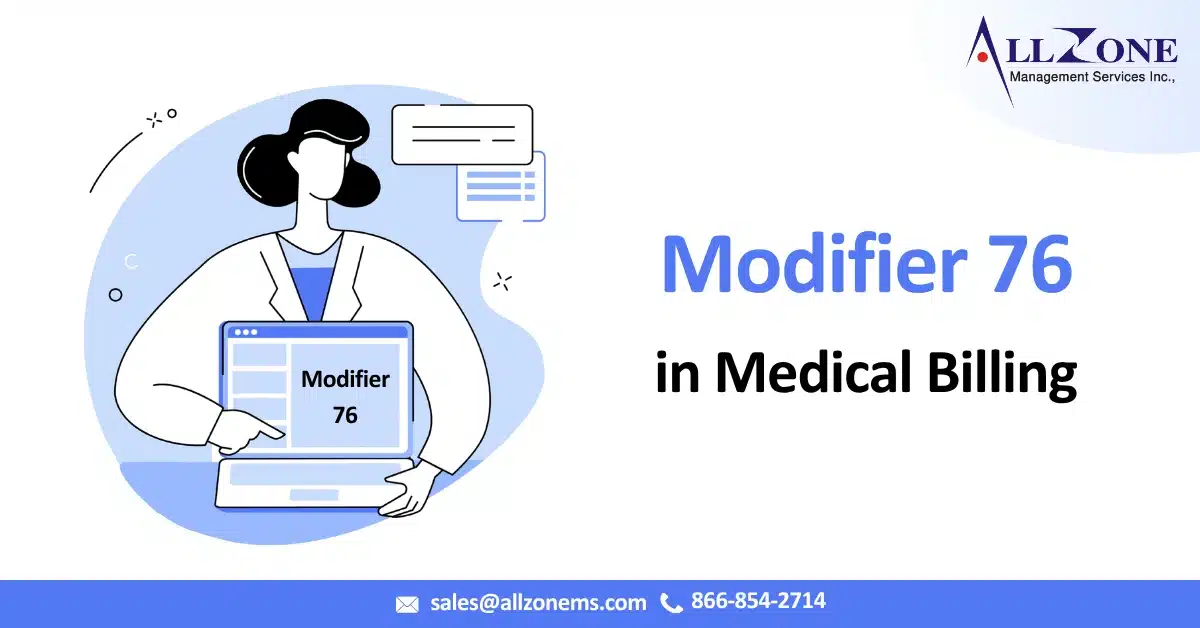Introduction
In medical billing, modifiers play a vital role in explaining the circumstances under which a service or procedure was performed. One such important modifier is Modifier 76, which helps billers and coders indicate when a repeat procedure or service is performed by the same physician or qualified healthcare professional.
Accurate use of Modifier 76 ensures compliance with payer guidelines and helps healthcare providers avoid claim denials due to misunderstanding of repeat procedures.
What Is Modifier 76?
Modifier 76 is defined by the American Medical Association (AMA) as:
“Repeat procedure or service by the same physician or other qualified healthcare professional.”
This modifier is appended to a CPT or HCPCS code when a procedure or service is repeated on the same day by the same provider for the same patient.
It helps differentiate the repeated service from a duplicate billing error and ensures that the payer recognizes the medical necessity for performing the same service again.
When to Use Modifier 76
You should append 76 Modifier when:
- The same procedure is performed more than once on the same day.
- The procedure is repeated by the same provider.
- The repeat service was medically necessary.
Example 1:
A patient undergoes a chest X-ray in the morning, and later the same day, the physician orders another X-ray to monitor changes.
- First X-ray: CPT 71046
- Second X-ray (same physician, same day): 71046–76
Example 2:
A cardiologist performs an ECG (electrocardiogram) in the morning. Due to abnormal results, a second ECG is performed later in the day.
- Report second ECG with 93000–76.
When NOT to Use Modifier 76
It’s equally important to know when not to use this modifier. Avoid using Modifier 76 if:
- The repeat service is performed by a different physician — in that case, use Modifier 77.
- The service was part of the same session or a continuous procedure (e.g., multiple views or steps within the same test).
- The repeated procedure was due to technical failure or poor image quality — then use Modifier 52 (Reduced Services) if applicable.
- The repeat procedure was planned or staged — use Modifier 58
Documentation Requirements for Modifier 76
Proper documentation is crucial to support the medical necessity of repeating a procedure. Missing or incomplete records can lead to claim denials or audit issues.
Include the following in your documentation:
- The reason for the repeat procedure (e.g., change in patient condition, follow-up results).
- Time and date of both the original and repeated services.
- Provider’s name to confirm it was the same physician or qualified professional.
- Supporting clinical notes, such as progress notes, imaging reports, or lab orders.
Common Mistakes When Using Modifier 76
Even experienced billers can make errors when applying Modifier 76. Here are some common pitfalls and how to avoid them:
| Mistake | Why It’s Wrong | Correct Action |
| Using Modifier 76 for repeat procedure by a different provider | Modifier 76 is only for the same provider | Use Modifier 77 |
| Reporting Modifier 76 without supporting documentation | Lacks proof of medical necessity | Add clinical notes explaining the repeat service |
| Applying Modifier 76 for related but not identical procedures | The modifier applies to identical CPT codes | Ensure both procedures share the same CPT code |
| Forgetting to append Modifier 76 to the second service | Leads to claim denial or duplicate edit | Always add Modifier 76 to the repeat service |
Modifier 76 vs Modifier 77
While both modifiers indicate repeat procedures, they differ based on who performs the procedure.
| Aspect | 76 | 77 |
| Performed by | Same physician | Different physician |
| Purpose | Indicates repeat of same service | Indicates same service by another provider |
| Example | Repeat X-ray by same radiologist | Repeat X-ray by another radiologist |
Payer Guidelines and Considerations
Each insurance payer (Medicare, Medicaid, commercial insurers) may have specific billing rules for Modifier 76.
Some payers may require:
- Distinct documentation or diagnosis codes to justify the repeat service.
- The modifier to be placed in the first modifier position on the claim.
- Electronic claims to include remarks explaining the reason for repetition.
Always check payer-specific manuals or Medicare’s National Correct Coding Initiative (NCCI) edits before submitting claims.
Impact of Modifier 76 on Reimbursement
Proper use of Modifier ensures that repeat procedures are reimbursed fairly rather than being flagged as duplicates.
Incorrect or missing modifiers can trigger:
- Claim denials for duplicate billing
- Payment delays
- Audit risk
Correctly applying this modifier demonstrates compliance and transparency — two key factors in maintaining payer trust and optimizing the revenue cycle.
Conclusion
Modifier 76 may seem straightforward, but accuracy is key in avoiding claim denials and maintaining compliance. By understanding when and how to use this modifier, medical coders and billers can ensure accurate claim submission, streamline reimbursements, and strengthen the overall revenue cycle.
If you’re struggling with complex coding and modifier rules, partnering with an experienced medical billing company like Allzone Management Services can help.
Our team of certified coders ensures every claim is compliant, accurately coded, and optimized for maximum reimbursement.

